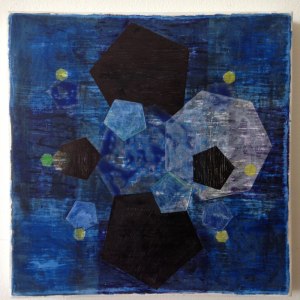Archive for November 2015
David Manley, A Winter Cycle at New Court Gallery
There’s a wonderful photograph by Gillian Wearing in which a young man holds a handwritten sign which reads: “Everything is connected in life, the point is to know it and to understand it”. David Manley’s set of abstract paintings The Winter Cycle, recently on show at New Court Gallery, Repton, could be said to celebrate such connectedness.
The paintings were occasioned by his moving studio from a shared complex of spaces in an industrial setting, to his home and in the removal rediscovering some small panel pictures he had begun and abandoned several years earlier. The new working space, facing a large window into the garden where seasonal changes are so visibly displayed, prompted the idea of reworking the panels into a series loosely based on the transition from winter to spring.
Shortly after starting the project, Manley’s chancing upon Julian Broadhurst’s recording of A Winter’s Journey a set of poems by Reg Keeling, could be seen as an example of synchronicity. The poems, written largely in Haiku form, find something close to a visual equivalence in the paintings, though the relationship is indirect, acausal even. After all, one could hardly expect an abstract painter to produce works of illustration.
Perhaps the nearest we get to the illustrative is The Dove, in which a dove-like form is clearly discernible, though one could wonder whether the reference is as much to Braque and Picasso as it is to the Keeling’s poem of the same title. I prefer to see similarities to the process or form of the poems rather than expecting to find one-to-one correspondences with their contents. For example, the 5/7/5 syllable count in the haiku format is itself paralleled in Manley’s often repeated layering of pentagons and heptagons.
In Manley’s Winter Cycle, 27 small panels take their titles from the poems in Keeling’s collection. These are supplemented by three larger works, one dedicated to Keeling, one to Broadhurst and one entitled Flute Interlude, which again mirrors process more than content in alluding to Broadhurt’s use, in the recording, of musical markers between the readings. I like that in many of these paintings the allusions are to other senses than sight, specifically to the auditory system and indeed also to the olfactory, as in the painting/poems A Smell of Woodsmoke and The Smell of Ripening Apples, as if to attempt to trigger synesthetic responses.
I can imagine the artist at times looking for connections, sometimes very conscious ones as in The Dove, and then, at other times noticing relationships to the recorded poems that he didn’t necessarily look for, like the kind of filtering that occurs when, for example you buy a new car in a colour you think is unique, only then to notice it everywhere. The paintings are abstract, autonomous, not dependent on representation, yet they cannot help but refer, just as the more autonomous a system, the more urgent are the connections to its environment. What seems to be emphasised here is indeed relationship but of a very indirect kind.




